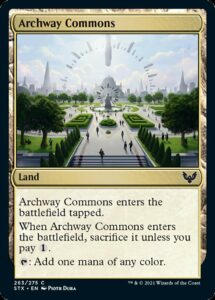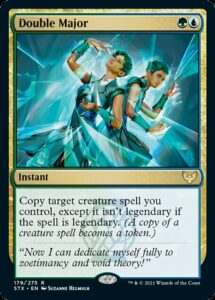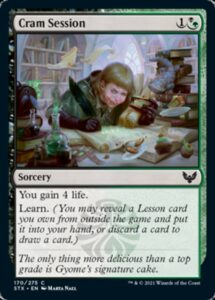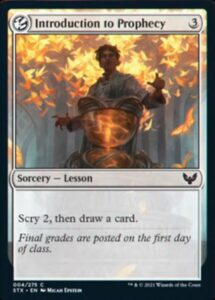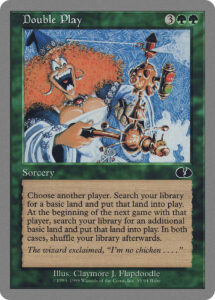Next week, Strixhaven arrives on Magic Arena and Magic Online. As always, a new set release means that there’s a new Limited format to learn.
Overview: Selecting a College
Strixhaven is an especially unusual set, which makes it harder to evaluate. We’ve seen many worlds defined by five two-color factions, but Strixhaven embraces very different play patterns than what we’ve seen before with the Ravnica guilds (one of only two worlds in Magic which features five enemy-color factions). There are no faction-specific mechanics, so the edges between the factions aren’t as clear as “the Kolaghan clan uses Dash to play aggressively” or “Jump-start enables both controlling and tempo Izzet decks.” Instead, each of the five colleges is build around general playstyles and game feel.
They have a variety of mini-themes between them (with the set’s new mechanics, Learn, Lessons, and Magecraft connecting them, but we’ll get to those in a minute) and a college-specific token that functions as its mascot. So, what are they all about?
Silverquill (WB) is the most aggressive faction. It has subthemes of +1/+1 counters, going wide, flying, and aristocrats (getting value when your creatures die). Its mascot is the Inkling, a 2/1 flying.
Prismari (UR) may be the hardest college to evaluate—it suggests that it’s about 5+ mana spells, but only two cards in the whole set reference them. Instead, I think Prismari is about generating one Big Turn, where you cast an enormous spell or a combination of spells that wildly swing the game’s tempo in your favor. It has subthemes of tempo, treasure ramp, instants and sorceries in your graveyard, and yes, 5+ mana value spells. Its mascot is the 4/4 Elemental token
Witherbloom (BG) is defined by lifegain, taking what’s always been a WB theme and turning it on its head. It has subthemes of lifegain and aristocrats. Its mascot is the 1/1 Pest which gains you 1 life when it dies.
Lorehold (RW) is perhaps the most novel reimagining of a color pair. Red-white is almost always the most aggressive color pair in any set. On Strixhaven, it may well accommodate the most controlling playstyle. It uses the graveyard as a resource and rewards you for removing cards from your graveyard. It also has a spirits subtheme which likely hews a bit more aggressive. Its mascot is the 3/2 Spirit.
Quandrix (GU) is the ramp college. It rewards you for achieving a threshold of 8 lands and has subthemes of +1/+1 counters and what can only be appropriately described as “awesome mathy stuff.” Its mascot is the 0/0 Fractal (which always comes with some number of +1/+1 counters).
Once you know how each of the five colleges work, the next step is finding common ground between colleges. With eight people drafting and only five colleges, there’s going to be pressure to take some courses in other schools. The easiest way to do this is to add one color to your college. So, if you’re Lorehold (RW), you’re looking to add either Silverquill (WB) or Prismari (UR).
There are some clear mechanical crossovers between colleges to enable three color play. Both black colleges reward sacrificing creatures, while both blue colleges reward large quantities of mana. Interestingly, Silverquill and Quandrix both have +1/+1 counter themes despite not being easy colleges to pair—which suggests that (as is often the case with five-faction sets) there viable 4-5 color decks. But rather than go too far down this speculative rabbit hole, there’s a more omnipresent throughline between the colleges: the set’s new mechanics.
Witchcraft
Strixhaven introduces four new mechanics: Magecraft, Learn, Lessons, and Magic’s latest evergreen keyword, Ward.
Ward might best be remembered as the Frost Titan ability, though it’s templated to function in a variety of ways—white, blue, and green function the same way that Frost Titan does, while black and red require life payments instead. This isn’t a mechanic you’ll be building draft decks around, but it’ll play the same role as Hexproof in Limited without eliminating your opponent’s ability to interact. I was initially surprised by the templating, since I’d assume that not having a triggered ability or “gotcha!” moments would make for cleaner gameplay (especially for digital Magic). Chris Mooney helpfully and thoroughly explained why this current wording works better—and it’s always a joy to see the little decisions that lead to the version we see in print.
Magecraft is an ability word (meaning it works differently on different cards, unlike keywords like Mentor that always work the same) that rewards you for casting and copying spells. It functions similarly to Prowess, except there’s a great diversity of effects it provides. The challenge of building Magecraft into a set is that draft decks simply don’t have room for much beyond creatures and removal spells. To solve that problem, Magic created a linked pair of two mechanics, and they’re the glue that brings together much of the lesson.
Modal Double-Faced cards return for the last time this cycle. Their appearance is the same as it was in Kaldheim—exclusively on rares and mythic rates, rendering them marginal for Strixhaven Limited.
Learn is a new keyword action. When you learn, you choose one of two things—you can tutor for any Lesson card in your sideboard or you can rummage (discard a card, then draw a card). You can also opt to do nothing if you’re out of Lessons and in danger of decking or love your hand.
Lesson is a new card type on sorceries. By itself, it doesn’t do or mean anything (like snow in Kaldheim). But in conjunction with the Learn mechanic, you can grab Lessons out of your sideboard. This allows you to artificially increase the density of instants and sorceries to enable Magecraft (and other spells-matter cards) without forcing taking up creature or removal slots.
Let’s Learn about Lessons
There is a lot going on with the design of Learn and Lessons. Learn is a tutoring mechanic, one of the most powerful and dangerous mechanics in Magic. It both draws you a card and gives you control over what that card is. Interestingly, Learn only seems seems to add 1 to a card’s mana cost. This contrasts with drawing a card, which tends to add 2 to a mana cost. When you look at Lessons, this makes sense, since most Lessons are overcosted and/or weak in effect to offset how powerful Learning them is.
One could imagine another world where that Lessons aren’t tutored for, but drawn randomly. In such a world, both Learn and Lessons could be more aggressively costed, since they’re card advantage without card filtering. And if you’ve played with Contraptions, you know that this is a solution with its own problems. Draft one good Contraption and the “right” way to build your deck is to only use that Contraption (so that you’re guaranteed to randomly assemble it first). Instead, we have weaker Lessons (which makes Learn weaker) all so that you’re rewarded for taking as many Lessons as possible—which absolutely makes sense in Magic School World and lets you play with the cool new mechanic more.
Strixhaven features twenty Lessons (nine of which are common—four colorless and one for each college) and twenty-one cards with Learn (ten of which are common and they’re mostly evenly distributed—if you double count hybrid cards, white, black, and green have three while blue and red have two). We’ll see how the format plays out, but every common colored lesson seems to hit a good sweet spot—they’re about half a mana too expensive for you to be excited to play them in your deck, but things you’ll be perfectly happy to Learn from your sideboard.
There’s also the question of how good Learn cards need to be—Guiding Voice and Hunt for Specimens aren’t exactly thrilling cards by themselves, but they are basically guaranteed to have a second effect stapled onto them to potentially make both cards more than the sum of their parts.
Strixhaven looks be to a tricky set to crack. It reminds me a bit of Ikoria—Magecraft and Lessons wind through all colors just as Mutate did. You get Lessons from out of the game just as you did with Companions (though Lessons are much, much weaker). The set has many quiet themes rather than a small number of loud ones. The only big concern I have is the amount of text that’s been creeping onto cards this year—I feel like I still see people forget abilities in Kaldheim draft despite the format having run its course—Strixhaven seems as wordy if not more so.
Thankfully, there’ll be plenty of time to crack the format. And if the Kaldheim Open was any indication, there’ll hopefully be opportunity to play some competitive Limited on Arena and leverage this practice!
Zachary Barash is a New York City-based game designer and the commissioner of Team Draft League. He designs for Kingdom Death: Monster, has a Game Design MFA from the NYU Game Center, and does freelance game design. When the stars align, he streams Magic (but the stars align way less often than he’d like).

